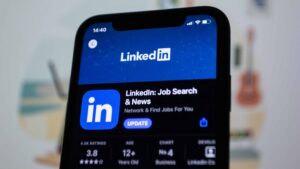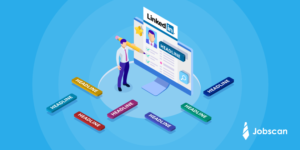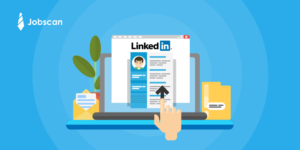Your professional history is the basis of your LinkedIn profile. You can create an overview of your past experience, job duties, projects, and volunteer work. Your colleagues can write you recommendations and vouch for your skill set. You can list skills that would be an asset to a potential employer.
LinkedIn has a robust Jobs section but benefits job seekers in other ways. It’s a virtual one-stop shop for professionals looking to advance their careers.
With that in mind, LinkedIn is also a pretty competitive place. Your professional profile needs to stand out in the right ways to attract the attention of recruiters.
In this article, we’ll share a list of things you can do to create the perfect LinkedIn profile.
1. Professional photo
It’s a big no-no in the US business world to include your photo on your resume, but the opposite is true on LinkedIn. Your photo should reflect your professional presence and not necessarily the one you would present to friends and family on Facebook or Twitter.
Consider having a photographer help you with headshots. Dress appropriately and steer clear of busy backgrounds. Avoid using any photos with other people in them. Avoid shots of yourself doing anything you wouldn’t do at the office—say, holding a red Solo cup while wearing a lampshade on your head.
2. Join LinkedIn groups
LinkedIn Groups are a great way to meet professionals in your field. They are also a way for you to demonstrate that you have a passion for your industry. You can choose which of your group memberships are visible on your LinkedIn profile.
Participating in groups can lead you to opportunities later in your career. Post insightful comments in group discussions and you just might catch a hiring manager’s eye. You never know where your next big lead will come from or whether you’ll meet someone influential. Networking in your industry, even online, is a great way to set yourself up for success.
3. Write a great LinkedIn profile summary
Your LinkedIn summary is your opportunity to quickly introduce yourself to someone– your elevator pitch. Lead off your LinkedIn profile by giving some insight into who you are as a person. Consider writing your summary in the first person and giving it some personality. A summary on LinkedIn can be somewhat less formal than a typical resume summary. Good LinkedIn profile summaries range between 250-300 words and take advantage of the generous 2000 character limit.
Keep in mind that LinkedIn is essentially a giant search engine, and your summary can play a big role in where you fall in the results. It’s crucial to find out which keywords best reflect your industry, area of expertise, and passions and include them in your summary.
With Jobscan LinkedIn Optimization, you can scan your profile to find out exactly what keywords you should include for the jobs you want. Receive your profile score and actionable tips to boost your profile’s searchability, professionalism, and over impact.
4. Experience
Your work experience makes up the largest part of your profile. While it might seem like a duplicate of the work experience section of your resume, you can optimize it for LinkedIn.
For example, keywords are important. Do some research on your industry and learn which keywords recruiters and hiring managers are targeting.
Listing the specific software and hardware that you use in your work can be helpful. Relevant keywords can also include techniques, credentials, industry-specific terms, and more. Having the right keywords in your LinkedIn profile can bolster your credibility and boost your visibility.
5. Skills and endorsements
Your skill set is a list of assets you bring to the table as an employee, and your contacts on LinkedIn have the opportunity to endorse these skills.
These skills include things such as video editing, digital media, and technical writing. If you’re a developer, for example, it includes specific languages that you are experienced with.
Endorsing other people’s skills can encourage them to endorse your skills in return. Typically, you’ll find that specific skills you are best known for rise to the top of the list as endorsements come in.
One thing to keep in mind here: Blindly endorsing someone you don’t know well can backfire. Remember, endorsements are not anonymous and you are putting your name behind someone’s ability to do something, helping to shape their professional profile.
6. Recommendations
Recommendations are a big part of LinkedIn. People you have worked with can write a short recommendation based on their experience with you.
A lot of hiring managers will look specifically at this part of your LinkedIn profile as it offers them insight into how well you work with others and what type of impression you left at previous jobs.
Getting recommendations can be tricky, especially if you don’t want to just come out and ask for them. Instead, consider first recommending people you’ve worked with. It’s a subtle way of inspiring people to write recommendations for you, without actually asking.
Plus, after you’ve written a recommendation, you get the warm and fuzzy feeling that comes with doing something nice for someone.
7. Posts
Posts are a great way to gain attention on LinkedIn and establish yourself as an expert in your field. Why is it worth doing? Because it elevates your position as a professional by showing that you care enough to share insight, initiate conversation, and raise the collective understanding of your industry.
The quality of your posts is important, and so is the fact that your LinkedIn posts have a greater chance of being seen by a recruiter than your posts on other social networks.
8. Edit your public profile URL
The default URL that comes with your LinkedIn account is difficult to share with people. Who will remember a string of random numbers? Instead, customize your URL from LinkedIn’s Public Profile Settings page. Create a custom URL that includes your name separated by dashes, such as:
- linkedin.com/in/john-doe
- linkedin.com/in/john-doe-chicago
- linkedin.com/in/john-doe-project-manager
A customized URL is easier to remember and tell to people, and it looks good on a business card or resume. There are also SEO (search engine optimization) benefits. The perfect LinkedIn profile, after all, is one that’s inherently easy to find.
Originally published on Dec 1, 2015. Content updated for 2017.
















